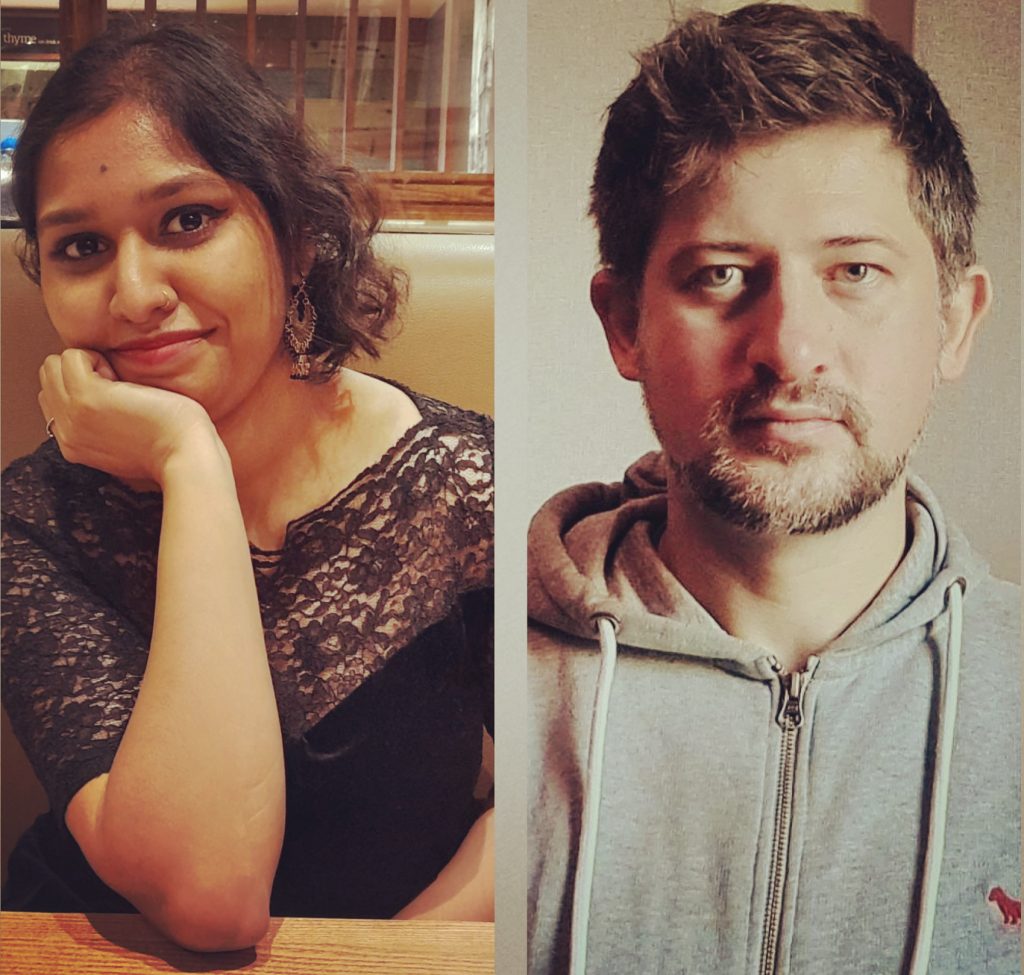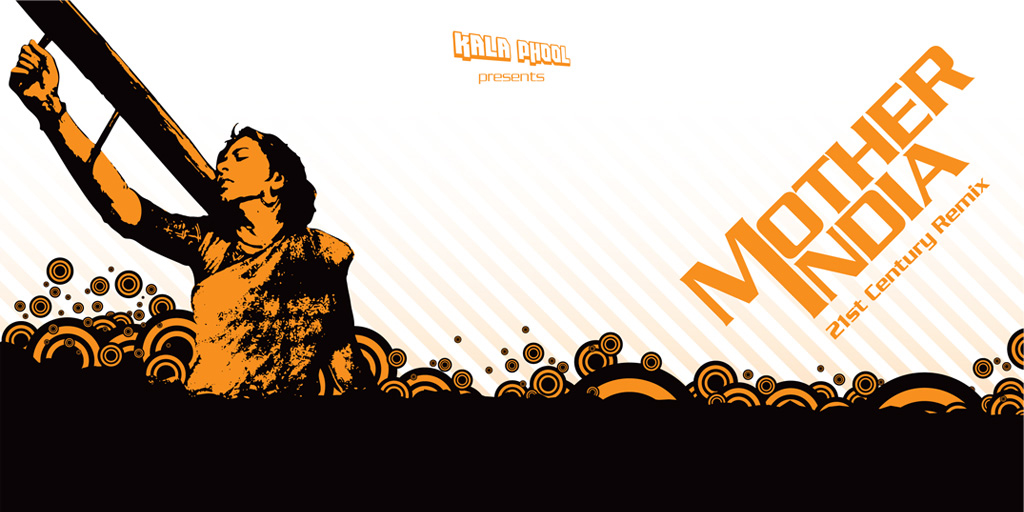 Mother India 21st Century Remix (also known as ‘MI21’) was a live music to film project that re-scored, re-visualized and re-presented the iconic ‘tour-de-force’ of Indian cinema, ‘Mother India’.
Mother India 21st Century Remix (also known as ‘MI21’) was a live music to film project that re-scored, re-visualized and re-presented the iconic ‘tour-de-force’ of Indian cinema, ‘Mother India’.
Directed by Mehboob Khan, the original 3-hour post-independence Bollywood epic was first screened in 1957 and was nominated for an Oscar as ‘Best Foreign Language Film’.
Lauded for its stunning cinematography, indelible soundtrack, compelling storyline and powerful performances, the film came to symbolize the post-colonial Indian psyche interpreted through the ambitions, struggles, compassion and endurance of the main character Radha, the metaphorical ‘Mother India’ of the story, played by Indian actress Nargis.
Whilst profoundly influential on Indian cinema and despite its native popularity, Mother India remains largely unknown and unseen outside the older South Asian community even though it’s universal themes of poverty and exploitation, courage and integrity, abuse and the role of women in society are arguably as relevant today as ever.
Kala Phool’s mission has been to bring this classic film to new, wider and more diverse global audiences in a way that both celebrates the original and drives new audiences to it, whilst also offering a fresh new experience to those already familiar with it.
Kala Phool’s first iteration of MI21 created a new, live electronic and classical music score set to a 45-minute silent re-edit of the original film, designed to portray the main narrative, articulate the metaphorical beauty of the cinematography and to forefront the key philosophical questions posed by the film.
Removing the dialogue, subtitles and any spoken narrative meant that we could take out any language and cultural barriers to experiencing the film. This also meant that the piece could communicate solely through the stunning operatic performances, the mastery of Mehboob Khan’s metaphorical cinematography and how our selected and edited scenes emphasised key parts of the narrative..
The response to MI21 (version 1) was fantastic, selling out two UK and international tours, to extremely diverse audiences, playing to over 35,000 people, filling venues and festivals in New York, Singapore, Australia, including London’s South Bank Centre and Sydney’s Royal Opera House.
The critical response was equally as effusive, with the Guardian, among others saying; “MI21 is a powerful and moving glimpse of a challenging, unwieldy masterpiece”.
The response at the time showed the potential for an even wider audience for the project and a much greater opportunity to celebrate and bring new people to the original iconic film.
2022 sees the 75th Anniversary of Indian Independence and the 65th anniversary of the release of Mother India and, inspired by this, Kala Phool has embarked on a Research and Development to revisit some of the key creative themes of Mother India through the eyes of a cohort of artists from across the UK.
With funding from Arts Council England, and partnering with Professor Rajinder Dudrah at Birmingham City University as co-investigator on the venture, this second iteration of the Mother India project culminates in a series of new works from our creative collaborators.
Each artist has produced a unique response to the Mother Film through their individual creativity.
Furthermore, the opportunity to research a ‘slice’ of the original musical score within the film, gave us time to explore the scene in which Radha is almost willing to give herself to the money lender, Sukhilala. Whilst enduring his ongoing exploitation of her dire circumstances, she reaches into herself to find a way out…not just for herself, but for her remaining children, and ultimately for the survival of her community, and Mother India.
The opportunity to explore the score saw us commission two musicians, Matt Constantine and Nimrita Kaur. Working together, and individually, they have created three tracks inspired by the scene chosen from the film (see below). Matt has explored the themes, history and musicality of the film in his final document titled ‘O Jane Walo Jao Na – Reduced Score – Matt Constantine, 2022’ – all shared below.
We are proud to present to you the work of the Mother India team…
ANISHA PARMAR – Jeweller
Anisha has been exploring the role of Radha’s wedding bangles from the film whilst linking the work to her own ‘Empowered Adornment’ project.
ANAND CHHABRA – Photographer and Archivist
From his award-winning ‘Apna Heritage’ archive of images charting the migration of the Punjabi community to Wolverhampton, Anand has curated a capsule collection showcasing the lives of many women who made the city their home.
- Black Country Visual Art – bcva.info
- reframed.uk
RUPINDER KAUR – Poet
Exploring the notions of ‘Goddess’, who views the female as such, how one sees themselves and floating between languages, Rupinder is exploring the film through poetry. Truly captivating.
DILWARA BEGUM – Visual Artist
There is a scene in the film where Radha sacrifices one of her son’s in the name of honour. The space between life and death is something Dilwara explores through her work and invites us all to participate when we need to.
PRITT KALSI – Digital Artist, Photographer and Videographer
There is a scene in the film where Radha sacrifices one of her son’s in the name of honour. The space between life and death is something Dilwara explores through her work and invites us all to participate when we need to.
MATT CONSTANTINE – Musician
There is a scene in the film where Radha sacrifices one of her son’s in the name of honour. The space between life and death is something Dilwara explores through her work and invites us all to participate when we need to.
The Call to All
This section of the film was chosen as it chronicles a pivotal moment for the protagonist Radha. As the village has been decimated by a flood – homes destroyed, many killed (including Radha’s youngest child) – people pack up their belongings and prepare to move on to somewhere new.
Radha speaks out and implores everyone not to abandon the land but to stay and reclaim it. This elevates her to a senior position, becoming the Mother of the new community. While only a few minutes in the film, this montage (along with the following montage) also represents a significant portion of Radha’s life. At the start she is a young woman with young children and by the end she has become older with adult children.
I used a yearning ‘cello to represent Radha’s heartfelt plea. The music opens with large chords in tribute to the opening chords of Naushad’s original score (although different chords). These chords set the scene which develops into a track in 6/8 (Naushad also used 6/8 here) with a slow unison melody over the rhythms below.
Towards the end, the positive response by the Radha’s audience is reflected by flute arpeggios and woodwind.
The Great Rebuild
This track follows the rebuilding of the village after the devastation in the previous section. Very quickly we see crops growing and coming to harvest in plenty. The music follows a very different style to the last track being more electronic in nature.
The track needed to be positive at its core but also driving and reflective of the hard, gruelling work that needed to be done.
There are also other sides to this section – Radha dreams of the past, remembering the happy times, for this section, I wanted to emphasise the dreamy quality and brought in two duetting electric cellos to meander around this section.
Similarly there is another dreamlike section, with swings swinging from trees in the center of the fields. This time, it is the present and Ramu’s romance begins with his future wife. Again I wanted to emphasise the dreamlike quality and let the bansuri solo here to create this mood.
The final section sees us again at the harvest, with lots of dancing, celebration and some of the most iconic images of the film such as the harvested wheat being arranged into the image of India (pre-partition).
O Jane Walo Jao Na – Reduced Score – Matt Constantine, 2022
Here we see the score analysis as viewed and interpreted by Matt as an insight to what it takes to score such an epic and multi-layered masterpiece such as this film – 220329_MI21_Score_O Janewalo Jao Na
Score Analysis
The score research and analysis has also been dissected by Matt, his approach, his understanding and research of such a feat of musicality is all set out in the following document – 220324_MI21_Analysis_The Music of Mother India
A ‘slice’ from the film Mother India was used by both Matt and Nimrita to explore the score and to create a musical response to this part of the film.
NIMRITA KAUR – Musician
The Assault
For me, “Mother India” was a film I hadn’t watched before so when I did for the first time, I remember thinking about some of the main themes about womanhood and how she has had to sacrifice a lot of her own comforts, pride and even finances (the bangles and jewellery) to ensure her family’s safety and survival.
Along with Matt Constatine, re-imagining the score for the scene in which she is assaulted by Sukhi-lal is something that struck a chord in me from the first time I saw it. It just reminded me that the same film which was made a long time ago is still unfortunately very true and relevant to society to this day, where women still have to fight for even the simplest of rights and safety. It is one of the most iconic, gripping and perspective-shifting scenes and I wanted to compose a score which was in my style but true and parallel to the original scene and idea behind it.
For me, composing this with the air of cinematic drama is something that I find natural to me and so, this scene would help me to explore some of the fundamentals in Indian classical music that Naushad had used before-hand. This would also be the scene in which I would also be mixing a little experimental and newer sounds that could help darken or press the seriousness of the grave crime that was committed against Radha.
Throughout the piece, I used a lot of ambient and dark synthesiser pads to help set up a foundation and as a means of fore-shadowing of what was going to be shown later. I also kept and used Indian classical instruments like tabla and tanpura to help the film stay true to its origins. In this scene in particular, I also wanted to set and explore the idea of using music as a sort of sound design or soundscape. For example, in the beginning of the scene, Sukhi-lal’s voice begins to muffle and lose clarity until Radha’s voice cuts in. At the same time, I used a synth pad to replicate poor reception but in a much deeper tone and a lot of white noise that helps mask the end of Sukhi-lal’s dialogue. In this small part alone, I wanted there to be the representation of what it feels like to have someone’s voice lose meaning when they’ve wronged you and especially, when they’ve tried to justify why they did what they did or why what happened was the best thing. I wanted those few seconds to represent the abuser/abused relationship through sound.
Another example is when Radha is looking wonderingly at her necklace that’s gripped in her palm and until she’s stepping unsteadily till when she snatches the gold chain Sukhi-lal tied around her off and throws it to the ground. In those few minutes, I wanted to bring back the sense of gentleness and what Radha as a character stands for. She is a naturally kind-hearted woman who works hard for the sake of her family and village and I wanted what I composed to fully encapsulate that. The few strokes of the Tibetean singing bowls, my singing in the background, santoor and gentle dholak– I hope– brings that forward and until she stands up, the faint but ever-present dark synths are still there and play in a dissonant pattern, concluding that though she is still that kind woman, if threatened, she will stand up and fight for herself and all she holds dear. This was the idea and the theme I wanted to go with.
Overall, the piece that I composed for the scene is something that I stand very strongly for and that is the empowerment of women all over the world. She is many things, a mother, a wife, a sister, a daughter-in-law but of all things, she is first and foremost a woman, someone who is strong enough to bear children and work hard for them and her family. Radha is the shining example of this and I wanted my work to give justice to not only the film but Radha as a character.
Mother India is an extraordinary film and our creative research into it is an important step in understanding how much more work there is to do in expanding its reach across generations and cultures.
We have greatly enjoyed this process and have been surprised at the interest in this iconic film, even today. The longer-term aim of our work is to continue developing and growing the Mother India project, working collaboratively and creating new and inspiring works, research, music and opportunities to share with a wider audience.
Our enormous thanks to our partners who have enabled us to get this far:
- Arts Council England
- Birmingham City University
- Professor Rajinder Dudrah
- All of the Creative Team







